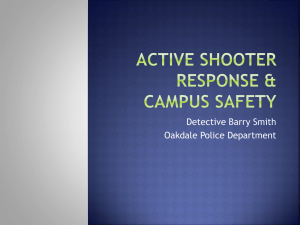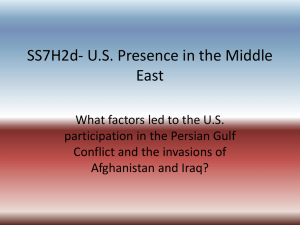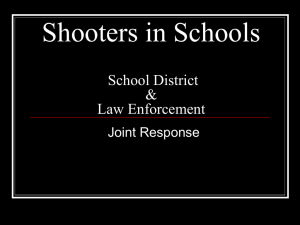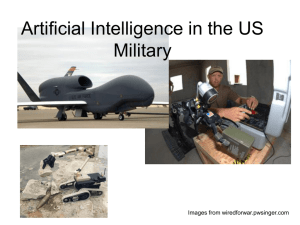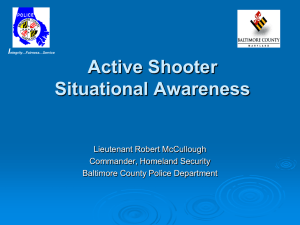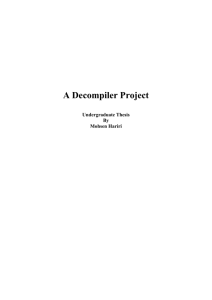Raytheon BBN Technologies: Boomerang - Boomerang
advertisement
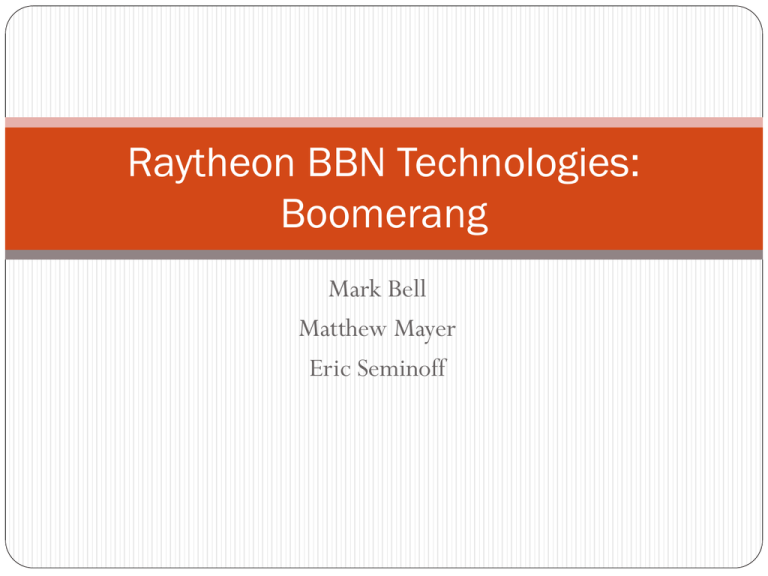
Raytheon BBN Technologies: Boomerang Mark Bell Matthew Mayer Eric Seminoff Problem Space Snipers have become the second greatest cause of fatalities in combat in Iraq and Afghanistan. Enemy fighters were shooting at convoys. The noise from the vehicles often resulted in our soldiers and marines being unaware they were under an attack until bullets hit them or their vehicles. Even if soldiers realize they are under attack, they usually have a hard time figuring out where the shots are coming from. Tarmiyah, Iraq Hidden sniper stalking U.S. troops. Najaf, Iraq Picture of an Iraqi Shiite militia sniper shooting at US troops from an empty building Problem Space cont. As a result of these continuous attacks and the casualties they were inflicting, U.S. Defense Secretary Donald Rumsfeld sought to develop a solution to this problem in Iraq and Afghanistan Proposed requirements for this technology: Shooter localization to plus or minus 15 degree accuracy within one second of the shot The ability to detect shots within a range of one to 30 meters Ability to detect and localize fire from AK-47s and other small arms at ranges from 50 to 150 meters Reliable performance in urban environments with low buildings Operable when mounted on a vehicle moving up to 60 MPH on various types of terrain Ability to withstand sand, pebbles, rain, and light foliage impacts Ability to deliver alert information in both a voice announcement and on an LED display Microphone array and electronics box must be able to be replaced in the field Solution: Boomerang Solution cont. Developed and manufactured by BBN technologies of Cambridge, MA (Raytheon) in 2003. Mounted to buildings, Humvees, Stryker armored vehicles and even hand-pulled carts. They are also mounted at checkpoints and on top of compound walls, hospitals and other military installations. The boomerang attaches on a mast to the rear of a vehicle and uses an array of seven small microphone sensors. Sensors detect and measure the muzzle blast and the supersonic shock wave from a bullet traveling through the air. Since bullets travel faster than the speed of sound, a shockwave is created from air particles being pushed aside. Solution cont. As the gun is fired and the bullet’s shockwave expands outward, a computer program records the different times at which the shockwave arrives at each microphone. Boomerang then uses sophisticated algorithms to compute: The direction the bullet is coming from Distance above the ground Range to the shooter Once this information is computed, users receive simultaneous visual and auditory information on the shooters location from an LED 12-hour clock image display panel as well as a speaker. The system then resets for subsequent shot detection. Solution cont. •Example of Boomerang III control •Mounts inside of vehicles Potential Problems / Analysis of Proposed Technology Cost •$15,000 per system •Most of this goes towards the processing unit. Facts The system is designed to detect rounds fired from almost any small arms weapon, The system has two variation with a third in development (Boomerang I, II, III respectively), The first system Boomerang I was first tested in Boomerang II was deployed in 2008 sending 1100 systems to US forces in Iraq and Afghanistan. System Accuracy False shot detections are less than one per thousand hours of system operation at vehicle speeds under 50 miles per hour. Missed shots are less than one per 500 shots at vehicle speeds under 50 miles per hour. Data Combat tested, There are around 6000 boomerang systems in Iraq and Afghanistan, They are estimated to have saved more than 100 lives in the last few years Installation takes 1 hour Training only takes 30 minutes Advantages -Quickly detect and locate incoming small arms fire, -Alerts with both a visual and audible queue when being fired upon, -Is not triggered by return fire, -Can distinguish between gunshots and other ambient noises (i.e. fireworks, car backfiring) this is because it only detects supersonic noises and this rules out almost anything except gunfire -Can track multiple enemies at once -Combat tested and reliable Disadvantages Right now it is only available to military and federal agencies Cost is quite high for local police departments to buy Acceptance / Pushback -The Boomerang system has received great acceptance from the end user Disruptive/sustaining The Boomerang System is a disruptive technology and this is the reason for the cost of it being so high. Future Vision Boomerang Perimeter Defense Boomerang Position and Heading Sensor Boomerang Warrior Boomerang Perimeter Defense Solution Description Strategically placed sensor arrays, Boomerang Server and networking infrastructure Scalable architecture Fully networked for instant shooter location reports Shooter location information displayed locally and to other third-party systems Solution Characteristics Simple operation Operates in any environment No calibration Easy to maintain Reliable shooter detection Minimal training required and localization No false alerts Full 360-degree coverage Hostile shooter localization in azimuth, range and elevation Boomerang Warrior Features Full 360-degree coverage with no signal blockage from head, torso, knapsack Operates in all orientations (standing, leaning, or prone) Full motion compensation Hostile shooter localization in: Azimuth Range Elevation Wrist mounted visual display and earpiece audio alert Return fire alert suppression Performance Shot detection >95% False alerts <1% Response time <1.5 seconds Total weight: 2lbs Operating temperature range: -20 to 50 degrees Celsius Recommendation This is an extremely useful technology that is helping save the lives of US forces, but it can be applied in many other areas and put to good use. We recommend that this technology continue to be improved, maintained and implemented in any hostile environment.




